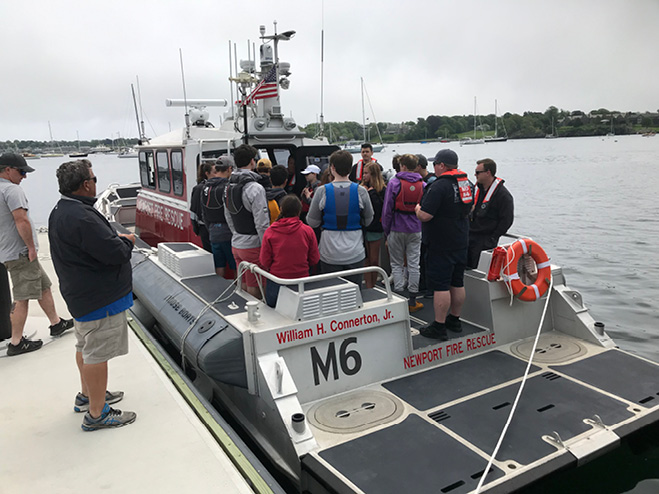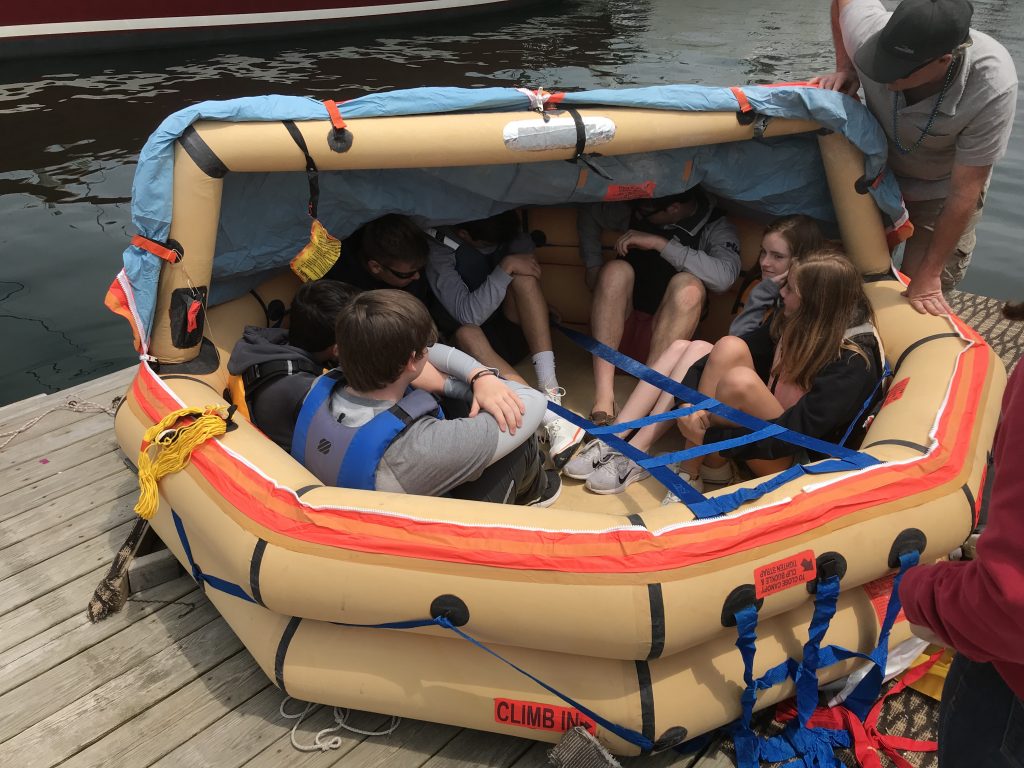By Joe Cooper
Phew, that was some spring. Herreshoff Regatta in Maine, the last Friday Night Lights, then the State Championships, a long Sunday event at Sail Newport, with 10 races. Then the Storm Trysail Foundation’s Junior Safety at Sea Seminar on 2 June, at Sail Newport. In the middle, another Block Island Race on the J/105 Young American – my favorite mob to sail with these days. The first part of the race was sailed in a brisk NW breeze, 20-30 knots, and got us down Plum Gut in 6.5 hours (with electricity this time). Around “1BI,” down the east side of Block and back into the Race on the flood. Finished about 0200 Sunday.
One of the interesting parts of sailing with these youth sailors is managing the younger, less experienced ones in hard winds at night with the boat going 10-12 knots. Life jackets are the norm, but watching the kids moving around the boat, I think, “How do you train kids in the boat smarts that keeps the more skilled (read: experienced) on the boat? Peter Becker, a key founder of the Young American Sailing Academy (YASA), and I muse on this “seamanship” factor regularly. Of this, more anon. In the meantime, on to 02 June.
Fifteen teenagers, including a soccer mom vanload of six from Clinton, CT, arrived and we did the full day Junior SAS. A spectrum of three boats: an IMX-40, pretty typical of a cruiser/club racer these days, with a headfoil; a Baltic 47, set up for cruising, including a roller furler; and a Class40 with hank-on headsails gave the instructors and kids a wide view of an interesting cross section of boats. On deck, down below, Man Overboard theory interspersed with a lovely 30-minute presentation by Gary Jobson, wonderfully wrapped up with lessons at the end of each sea story. And a visit from the Newport Fire rescue boat on things to expect if you’re on a boat needing Medivac activity. Interestingly, they were called away mid-presentation to an actual injury event.
Then next day, straight into preparing to sail back with a client on his Quest 33s, in the Doublehanded leg of the Bermuda 1-2. There are of course these days a long list of requirements that crews must discuss and have plans for. Several years ago, while preparing for the Ida Lewis Distance Race with a collection of sailors from The Prout School sailing team, I did just that, at least on paper. This ended up being a spreadsheet I call “The Eight Things.” Can you identify The Eight Things that may befall sailors at sea?

Hosted by yacht clubs and sailing centers around the Northeast and beyond, the Storm Trysail Foundations’s Junior Safety-at-Sea Seminars are exceptional hands-on learning experiences. © Joe Cooper/joecoopersailing.com
One of the most interesting discussions, and plans, we compiled for the DH leg were MOB and Abandon Ship. In the former, there are no spotters, no one down below to hit the MOB button. Maybe the autopilot is steering and the other is having a kip…there are many, many variables in THIS case. In the event you can get alongside the MOB, how then do you get them back on board? What is YOUR plan? We developed several.
On Saturday 08 June the Bermuda 1-2 went off, starting in the channel between Rose and Goat Islands. To the north of us was an Opti and Club 420 regatta and north of the bridge the IC37s and the Leukemia Cup. All across this spectrum of sailing, the idea of Safety is driven into us day in and day out. Yet one of the common threads Becker and I muse on is that Safety is almost always connected to “Stuff.” Rafts, flares, life slings, personal AIS, lifejackets, harnesses, and so on. I have a copy of the Offshore Special Regs. from the early 1990s. It is about 30 pages. Today it’s 61 pages.
Completion of a Safety-at-Sea Seminar is now required in almost any offshore race in the world. Even in these seminars, there are limitations. I have been an instructor in a “get in the raft in the pool” sessions and the issues surrounding the physical fitness of about half the participants in one recent seminar leads me to think they could not get into a raft had they the need to do so in anger. And any and all of these safety at sea considerations are likely cubed for the solo sailor.
As I write (10 June), seven entrants (of 27 starters) have withdrawn from the BDA 1-2. One blown out primary headsail, one set of banged up ribs after being thrown across the boat, one engine failure, one sail handling kit failure, (in-mast furling main), a couple of AP failures, and one with “too much not going right” – not enough preparation, in other words. And this in a race that people prepare for, starting several years in advance of actually pulling the pin and entering the race, let alone starting. One sailor, a mate of mine, eschewed the race and started out on about 5 June just to sail to Bermuda without the pressure of racing, on his own, that is, without any other competitors on the course.
All of these guys (yes, all guys) have put in a minimum of two years preparing for this race. I worked with nine guys in my specialty – sails and rigging set-ups so you can change gears in the ocean easily – and half of them had several tens of hours on the systems before starting. BUT what of the rest of the gear needed to make a 700-mile passage across some potentially nasty waters? Engine reliability, watertightness? How much water will get in through the cockpit hatches? (I don’t care how much rubber sealant there is, water will get in). Are there electrical components under the hatch lid? How is the reefing system going to work without chafe? Is the rig really solid and stable? Battery charging and capacity? The list is endless, before getting anywhere near the list of flares and gizmos.
Becker and I once did a really dopey delivery we affectionally dubbed the Ice Station Zebra adventure. Details not germane here, but the point is our experience in sailing and seamanship (and plain old sailing background) got our collective backsides back to land in one piece. Gizmos not required. Yes, I know I am going to get letters on this seemingly nonchalant approach to Safety, but the key missing component Becker and I think of is the thinking that goes into seamanship. Fundamentally, seamanship is a mindset, not a thing from the boat shop.
One of the laugh lines I use with the new kids on the sailing team is the idea of seamanship is like using your Jedi skills to see into the future. I say laugh lines, but it is serious – it’s the capacity to “look” into the future. What is going to happen in the next couple, or 5, 15, 60 minutes? What are the likely issues to contemplate, and how will you respond to them? Are the lines neatly stowed? Has someone checked the steering cables in the last watch? Has the “nip”* been changed? Even before the boat leaves the dock, has the boat contemplated The Eight Things?
In the above noted life raft sessions, I paint a picture of a boat in the ocean hitting something and starting to sink and you have 90 seconds to act. I pose the question, “What is the first thing you need to do?” The tepid responses to this question are typical from those not used to serious, high-stress events, and so are ill prepared to negotiate same. When you have 90 seconds to make a lot of decisions and actions and tasks to complete, and in the right order and with a degree of calm possibly not to dissimilar to a military action, few, not so well trained, are ready to cope with such pressure.
There are few answers: get the raft, trigger the EPIRB, put out a MAYDAY, and so on. One person suggested, “Make a plan.” I let that run for a minute, then circling back, 90 seconds is not the time to make a plan. When is the best time? When you go home from this seminar. I show a laminated copy of The Eight Things and people are amazed that it exists. “What a great idea” many observe…
In 90 seconds, who is going to do what? In discussing the Abandon Ship protocols with my DH mate, we dissected it pretty finely. What are the criteria for abandoning ship? Silly question? Well, clarity of decision and instruction is paramount in such conditions, I reckon. Someone must be charged to make that call. And a second person in the event the first (the owner?) is incapacitated. Who is going to do what? What needs to go with the crew into the raft?

© Joe Cooper/joecoopersailing.com
Who will get: the EPIRB, the ditch kit, the First Aid kit, extra food, water, flares the handheld VHF, the head count? What else do YOU think ought to go in the raft? Documents, money – ending up in Hamburg with neither passport nor money is just a pain, not insurmountable – but preparation is the key to seamanship. And what happens once in the raft?
Captain Bligh is commonly ridiculed as being the meanest of the mean. The responsibilities of an 18th century Royal Navy Captain not withstanding, Bligh successfully conducted one of seafaring’s longest open boat passages, largely due to seamanship and leadership. Contemplate this when thinking about what life will be like in an 8-man raft with eight people for a while. Ideally before needing to get into said raft. Bon Courage. ■
Australian born, Joe ‘Coop’ Cooper stayed in the U.S. after the 1980 America’s Cup where he was the boat captain and sailed as Grinder/Sewer-man on Australia. His whole career has focused on sailing, especially the short-handed aspects of it. He lives in Middletown, RI where he coaches, consults and writes on his blog, joecoopersailing.com, when not paying attention to his wife, college senior son, dog and several, mainly small, boats.
* Change the Nip refers to moving a loaded line, say a halyard, a bit one way or the other, so the chafe point is moved. A good thing to do with halyards every few hours on a long passage.




